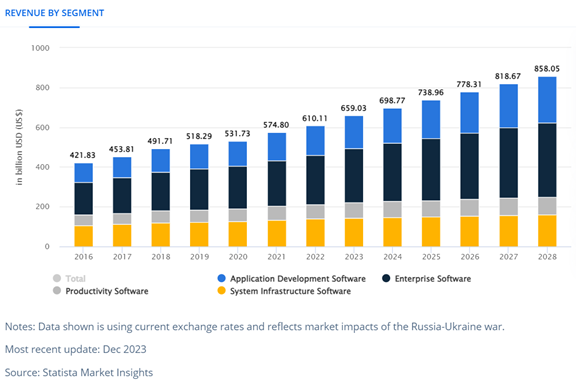Protecting your Business in the Evolving Virtualisation Landscape

The Market
-
According to a forecast published by Statista, Revenue in the Software market is projected to reach £549.70bn in 2024.
-
Enterprise Software dominates the market with a projected market volume of £229.70bn in 2024.
-
Revenue is expected to show an annual growth rate (CAGR 2024-2028) of 3.14%, resulting in a market volume of £622.10bn by 2028.
-
In global comparison, most revenue will be generated in the United States (£278.10bn in 2024).
-
As of March 2024, Broadcom has a market cap of $606.48 Billion. This makes Broadcom the world’s 11th most valuable company

Change is the only constant, and your virtual data centre is no exception. Virtualisation is a cornerstone of today’s IT landscape, optimising resources and revolutionising business operations. While VMware has been a long-time leader, recent events, including Broadcom’s acquisition, have ignited interest in alternative platforms.
Switching hypervisors is a significant decision that requires careful consideration of your data resilience strategy. Whether transitioning between vendors or migrating to new platforms, our expertise ensures your business operates safely, securely, and without data loss at any scale.
There are many moving parts in an IT strategy: Application rationalisation, cloud migration, workload re-platforming, and refactoring. There is never enough time to do all the things the business wants. As an MSP for nearly 30 years we have worked with VMware for decades and took the time to consider what options are available to SMEs today.
Remembering Back to November 2023
Broadcom did make some assurances to the market when they were looking at the acquisition of VMware, declaring it would be different from the Symantec buyout, with the main concern being about storage and network adapters and bundling VMware with Broadcom software.
However, recent developments have seen various end users experiencing price hikes, limitations of choice, service degradation, or reduced innovation. Being an independent, vendor agnostic systems integrator has allowed us to explore alternative virtualisation and cloud platforms, meaning we have stayed true to our vision of always giving our customers the best solution for them. Pricing and bundling have been some of the main surprises regarding impact to businesses, forcing people towards buying features they don’t need or want, with VSAN being an example of this – paying extra for functionality that used to be free (e.g. Tanzu etc.) and the shift from socket based licensing to core based.
Options Overview
The Hypervisor gives you granular control so you can make the box do what you want for your business. In this blog, we shall start with an overview of the open source hypervisors before focusing on the proprietary ones and then looking at the hybrid choices so we can shed light on the distinctive features and benefits that make each platform a worthy contender in this dynamic landscape.
Open Source Hypervisors
- Xen Project:
- Features: Secure, high-performance, supports paravirtualisation and hardware-assisted virtualisation.
- Usage: Widely used in large-scale cloud environments (e.g. AWS).
- KVM (Kernel-based Virtual Machine):
- Features: Integrated into the Linux kernel, supports multiple architectures.
- Usage: Popular for both enterprise and cloud solutions, supported by major Linux distributions.
- Proxmox VE:
- Features: Combines KVM and LXC for both VMs and containers, web-based management interface.
- Usage: Suitable for small to medium-sized enterprises, ease of management.
- oVirt:
- Features: Enterprise-level virtualisation management, built on KVM.
- Usage: Designed for large-scale enterprise environments needing comprehensive VM management.
- VirtualBox:
- Features: Cross-platform, user-friendly, supports various guest OSes.
- Usage: Ideal for desktop virtualisation, development, and testing environments.
Proprietary Hypervisors
- VMware ESXi:
- Features: Robust, feature-rich, supports extensive enterprise use cases.
- Usage: Widely used in enterprise data centres for server virtualisation.
- Microsoft Hyper-V:
- Features: Integrated with Windows Server, supports both Windows and Linux guests.
- Usage: Common in enterprises using Windows Server environments.
- Oracle VM:
- Features: Based on Xen, optimized for Oracle products.
- Usage: Preferred in environments with heavy Oracle software usage.
- Citrix Hypervisor (formerly XenServer):
- Features: Based on Xen, focuses on desktop and server virtualisation.
- Usage: Used in Citrix VDI environments and enterprise virtual infrastructures.
Hybrid Hypervisors (Open Source Core with Commercial Support)
- Red Hat Virtualisation (RHV):
- Features: Based on KVM, integrated with Red Hat products and support.
- Usage: Enterprise environments seeking Red Hat ecosystem compatibility.
- SUSE Linux Enterprise Server (SLES) with KVM or Xen:
- Features: Offers both KVM and Xen with enterprise support from SUSE.
- Usage: Enterprises using the SUSE ecosystem, requiring professional support.
Choosing the right VMware alternative
The choice of a suitable VMware alternative is a pivotal decision for organisational success. With an array of options at your disposal, the key considerations in choosing the solution include scalability, security, user-friendliness, and the level of support and management provided by each solution.
Feel free to reach out and have a chat with the team who are very well versed in this space.



